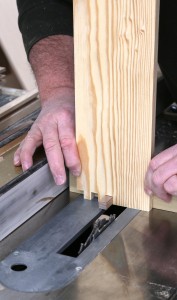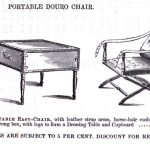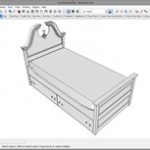We may receive a commission when you use our affiliate links. However, this does not impact our recommendations.
 Most of my projects have some form of dovetail joinery. Drawers have half-blind and through-dovetails joints, and drawer dividers generally attach to the case with sliding dovetails. In fact, other than the Southern Gent’s Mirror Stand from the August 2013 issue (#205), I cannot remember the last project to come out of my shop in which no dovetails were in the mix. As a form of protest, I’m tossing aside my dovetail layout guide, and shoving my dovetail saw inside a drawer. I’ve decided there will be no pins and tails on my next magazine project.
Most of my projects have some form of dovetail joinery. Drawers have half-blind and through-dovetails joints, and drawer dividers generally attach to the case with sliding dovetails. In fact, other than the Southern Gent’s Mirror Stand from the August 2013 issue (#205), I cannot remember the last project to come out of my shop in which no dovetails were in the mix. As a form of protest, I’m tossing aside my dovetail layout guide, and shoving my dovetail saw inside a drawer. I’ve decided there will be no pins and tails on my next magazine project.
What’s my next project? At a small antique shop in Lebanon, Ohio, I discovered a utilitarian, hinged-lid box that’s perfect for small-item storage.  I also think it will be a fun project for the magazine. The original box was joined with dovetails at all corners, but I’m using finger joints, sometimes called box joints. They’re a close kin to dovetails, and there’s plenty of strength.
I also think it will be a fun project for the magazine. The original box was joined with dovetails at all corners, but I’m using finger joints, sometimes called box joints. They’re a close kin to dovetails, and there’s plenty of strength.
There are a few different methods used to make finger joints – a table saw setup (what I use most of the time), and a router jig (such as those from Leigh Industries, or the Keller Dovetail System) are but two. Another option is to use a router table.
The table saw setup (as seen in the opening photo) uses the miter gauge, a sacrificial fence and a dado stack. The same setup can be used at a router table (shown at the right), but a router bit replaces the dado stack.
What method would be best to present in the magazine article? If you have an opinion, please share.
Here are some supplies and tools we find essential in our everyday work around the shop. We may receive a commission from sales referred by our links; however, we have carefully selected these products for their usefulness and quality.









The biggest problem with finger joints is getting the spacing of the key exactly right. Cumulative error really shows up at the end. The first few times I saw this taught (Tage Frid and Frank Klausz, both live) they both had problems tuning in the set up. Maybe if you used feeler gauges and a 1/4-20 thread (so that one revolution advanced 0.050″) you could do really accurate tuning. I saw a great way using spacers and a rip fence a couple of years ago and it gets it really close in first try or one adjustment. Incra Jig works and if your cutter is dead knuts on.
But to answer your question. Table saw, because:
1) Table saw is always out, router table take some set up and finding the right bit.
2) I think it has less tear-out on the back side
3) Well, I’m a table saw guy.
I like finger joints for small items. Much easier to do finger joints on a 1″ high 1/4 – 3/8 thick drawer sides for a jewelry box than to try to do itty-bitty dovetails. I suppose I could use a few pneumatic brads to hold while the glue sets up (HHJK).
Bobbollin, perhaps a table saw isn’t (or shouldn’t) be a tool most woodworkers have before a router or hand tools!
Cudos to Pop Wood which does mention alternate methods in many articles. Most other magazines ignore the fact. I think it should be stressed that there are almost always more ways to skin this cat.
And I think Farkled has an excellent suggestion which would accomplish that.
I would suggest that this would be an excellent opportunity to demonstrate how to make your own box-joint jig for the table saw. Most beginning woodworkers probably have a table saw. A router table would likely be a later acquisition. It’s not difficult to make an accurate tablesaw jig and it is certainly more instructive as well as considerably cheaper than buying a ready-made device.
Personal experience speaking here.
This is an easier joint to cut by hand than a dovetail, and faster. Choose a chisel close to your stock thickness, and set the fingers to the width of your chisel. Saw the fingers, mark the waste, and chop it out. These days glue does the job that used to need the reinforcement of the dovetail joint.
Incra I box makes perfect, no mess, very safe, finger joints/box joints with almost no learning curve. Easy Peasy. Table saw with either a dado blade, or a stack/swap finger joint blade, or on your router table. Tracks absolutely true using your miter slot, easily adjustable 1/8 through 3/4″ pins, in stock thicknesses 1/4 to 1″. Safe hands off usage, with a chip shield. Couldn’t pry mine from me.
http://www.incra.com/product_rtf_ibox.html
I suggest you take a look at the Freud Box Joint dado set as seen here: http://www.freudtools.com/p-316-box-joint-cutter-set.aspx I followed their instructions to the letter and got pretty good box joints on my first try. I’ve also made a couple of other box joint jigs (for use on the table saw only) and got good results with the “screw adjust” version. Woodcraft Magazine and Woodsmith Magazine both have published articles on “advanced” box joint jigs. The key to this operation is, well, the “key” and that must be made to EXACTLY the width of the blades doing the cutting. Do not assume that the Freud dado blades on their 1/4″ (or 3/8″) dadoes are 0.250″. Mine measure 0.254″ and those extra 4 thousandths add up over the course of 10 fingers!
use to do all my box joints on the table saw but about 10 years ago got Woodline’s Box joint jigs for the router could of made them, but price was good I can make 4 sizes of Box joints 1/8, (for my Shaker seed box accuracy) (special order) 1/4,3/8,1/2 they work great easy set up and I feel a lot safer then doing it on the table saw
I find the table saw the easiest to use. Why use a dado when a standard 1/8″ blade works fine for a box joint? A lot of boxes used to ship tools had these fine tooth joints in them.
Glen (or anybody), what’s the earliest that finger joints show up in work? I’ve always assumed that they were late 18th century or later.
Also I have a retail router jig for making this joint that is crap.
I am going to go for the Table saw version no matter which you suggest. I’ve been thinking about a project that would need it this Summer and if it’s important enough for Clay to keep his table saw for then I say let’s use it IF you were to use only one method. That being said they could be done by hand but not sure many would be interested in doing so.
Thanks Glen!
I’d prefer to see the table saw method. Better yet the hand cut method!
Since nobody seems to be voting on the presented options, let me recommend showing the router table setup. I don’t think it’s superior to the table saw, but it’s an option that’s available for the space constrained or budget constrained woodworker. Table saws and dado stacks require a certain amount of space and financial resources that aren’t so readily available to everybody.
For those who obsess about machines, there are also numerous screw advance box joint jigs for the table saw out there on the internet. I built the excellent one from woodgears.ca and it’s the biggest reason why there’s still a table saw in my very cramped workshop.